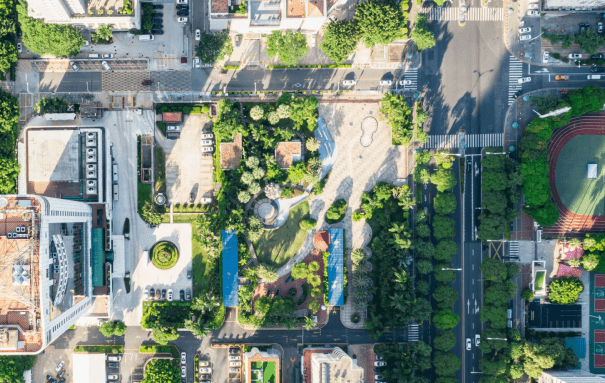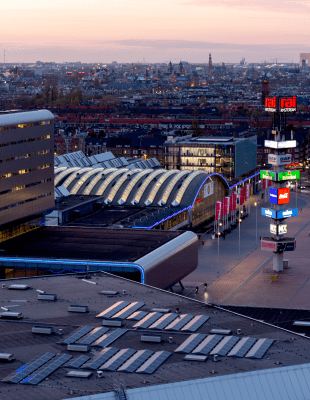The Urban Woods is going to be far more sustainable. It means if you have a normal building of around 7,000 square meters, which is in this case, you have to use almost 2.3 - 2.4 million kilograms of carbon to place it. Well, instead, if you grow a building, you store 1.2 - 1.3 million.
At the intersection of urbanization and climate change, there sits a major challenge: how can we keep constructing buildings for people to live in cities, when doing so generates massive carbon emissions that are fueling climate change? In the Dutch city of Delft, an innovative company may have found the solution: the Urban Woods. In this episode of Better Cities by Design, we spoke with Tim Vermeend, co-founder, and Jasmijn Rijcken, Chief Marketing Officer of the Urban Woods, about how they are constructing the tallest residential building in the Netherlands without a concrete core and how their new living concept can address other urban challenges like isolation and loneliness.
You have not accepted cookies yet
This content blocked. Please accept marketing cookies. You can do this here.
Subscribe on your favourite platform
Co-founder and architect Tim Vermeend joins us for this episode of the show and talks about his design for the Urban Woods in Delft. Globally, constructing and operating buildings is responsible for nearly 40% of energy-related carbon emissions. This means that cities won’t be able to achieve their net zero ambitions and we won’t be able to mitigate the impacts of climate change unless we learn how to build housing in cities without generating millions of tons of carbon emissions. Tim has designed the Urban Woods with a wooden core, instead of concrete, which is almost universally used. The production of concrete is devastatingly carbon-intensive, so swapping out concrete for a wooden core will make the construction of the Urban Woods not just carbon-neutral, but carbon negative, because the wood used will have absorbed carbon as it grew in the forest. We also talk with Tim about how the Urban Woods will also sport myriad other features that will make it highly sustainable to operate over the building’s lifespan.
Chief Marketing Officer Jasmijn Rijcken also joins the conversation and shares how the Urban Woods will be much more than merely a highly sustainable apartment complex; the building is designed to create a sense of community among residents. People who live in the Urban Woods will also have an app which will allow them to do things like upgrade their apartments in various ways, rent workspace in the building for the day, or even rent out a spare room to host visitors.


The Arcadis global podcast
Better Cities by Design
Episode transcript:
We recognize that not everyone is able to listen to our podcast, which is why the show is also available in text. If you would prefer to read what happened in the show instead of listening, please click the link below for the episode transcript.
-
Read full transcript
00:04
Davion Ford
Welcome to Better Cities by Design, a podcast brought to you by Arcadis, where we talk to change makers who are working to make our cities better places for people to live, work and play. I'm your host, Davion Ford. And this week we're going to the Dutch city of Delft to learn about a groundbreaking new residential living concept called the Urban Woods. I'll be speaking with the architect and co-founder of the Urban Woods, Tim Vermeend, as well as the Urban Woods’ Chief Marketing Officer Jasmijn Rijcken. We'll be talking about what makes the Urban Woods a breakthrough in sustainable building construction and operations, as well as how this new living concept is designed to combat other urbanization challenges such as housing security and loneliness.00:59
Davion Ford
The Dutch city of Delft is located in the province of South Holland. It's nestled between two of the Netherlands' largest cities, Rotterdam and The Hague. Though on a smaller scale, much like the city of Amsterdam, Delft is known for its ring of canals. Delft is also a very old city, which was officially chartered back in the year 1246. The city has a strong association with the Dutch royal family, the House of Orange. William of Orange took up residence in the city in 1572 as he was leading a growing resistance against Spanish occupation in the 80 Years' War. He was also killed in the city more than a decade later and laid to rest in the city's so-called New Church. Since then, that church has been the resting grounds of the Dutch Royals. And the city's old church is the burial site of the Dutch master painter, Johannes Vermeer. But arguably, the thing that Delft is most known for is Delftware, also known as Delft Blue, the distinctive light blue and white tinted glazed earthenware, which was and still is produced in the city. Now jumping to the present with a population of just over 100,000 people by international standards, Delft itself is not a large city, but Delft is part of what's known as the Randstad, which is one of the most densely populated parts of the world, which includes Amsterdam, Rotterdam, The Hague, and Utrecht as well as scores of other smaller cities. As such, people living in Delft are coping with many of the same challenges facing city dwellers all around the world. This includes dealing with the impacts of climate change and a pressing need for more housing, which is not only sustainable, but also affordable. And these two challenges are closely related to one another. The construction and operation of buildings is one of the main sources of carbon emissions that are driving climate change. And at the same time, we need a lot more buildings in cities in order to cope with urbanization. In other words, we need to build smarter and in harmony with nature.
And that's exactly what an innovative company is doing right now in Delft. I'm talking about the Urban Woods, which will be a multi-story apartment building that's designed and will be built in a manner that is fantastically sustainable. One part of the groundbreaking design that sets the Urban Woods apart is the fact that unlike traditional buildings, the Urban Woods will not have a concrete core. Instead, the building core will be made of wood. The result is a massive decrease in the so-called embodied carbon footprint of the building. Basically, swapping out the concrete literally saves millions of kilograms of carbon emissions. For more on this, here is Arcadis senior design architect Meint Smith. Meint and his team contributed to the design of the Urban Woods.03:56
Meint Smith
The client was noncompromising in their dedication to make this building as sustainable and organic as possible. This includes having a focus on both integrating vegetation onto the building facade and working to enhance biodiversity. But the main breakthrough with this building is the fact that it does not have a concrete core. To make this happen we designed wooden bracing into the facade for stability. The urban woods will be the tallest residential building in the Netherlands without a concrete core. This means that at the beginning of the building's lifespan it will have negative CO2 emissions because the trees used will already have stored carbon as they grew.04:35
Davion Ford
Now to learn more about this groundbreaking new way of building residential spaces, I'm really happy to invite two guests to the show, Tim Vermeend, architect and co-founder of the Urban Woods, as well as Jasmijn Rijcken, chief marketing officer for the Urban Woods.04:58
Davion Ford
Hello, Tim and Yasmine. Welcome to Better Cities by Design..05:01
Jasmijn Rijcken
Hello and good morning to you all!05:04
Davion Ford
So my first question is for both of you, what brought you to this project? And what are you trying to achieve with the Urban Woods?05:11
Tim Vermeend
We're trying to achieve a better life and a better world. In a sense, we thought that making houses from wood and adding a lot of nature to it would really help to feel better, as well in your building and in your environment.05:32
Jasmijn Rijcken
Yes, we envision real estate as a platform for a better future. So what is a better place to start than people's home, which is the core of people's lives. And we also want renting to be relevant again, because the industry did not change much, the renting is still very solid and didn't change, it’s static. And people changed a lot, a few 100 years. So let's make housing, look at housing different and make it relevant.06:02
Davion Ford
Tim, we know that traditional methods of building are often carbon intensive. In real terms, how much more sustainable will it be to build the Urban Woods.06:13
Tim Vermeend
The Urban Woods is going to be far more sustainable, it's just going to grow actually. And by growing, it will take a lot of carbon and this carbon will stay into the building as the building will stay a long time there. But to make it more clear in kilograms of carbon which some people will understand, it means like if you have a normal building of around 7,000 square meters, which is in this case, you have to use almost 2.3/2.4 million kilograms of carbon to place it. Well, instead, if you grow a building you store 1.2/1.3 million. And if you calculate this difference, this is a lot. And to make it more clear, you can bring it to a smaller size and say if you drive your car, you could drive 920 times around the Earth to have this amount of carbon being taken by your car. And if you imagine this, you will never drive this much around the Earth in your whole life. So I think this is a quite a clear point that at the moment, we're on the wrong way. And the Urban Woods is changing this and we also hope that people will follow these methods.07:29
Davion Ford
Okay, but how sustainable is it to cut down trees in the forest in order to build homes?07:35
Tim Vermeend
That's also a question I think that many people have in their mind when they’re thinking about cutting trees. Cutting trees is actually really good for the forest, all trees will not take up that much carbon and young trees will get more lively. So what happens is every tree we take down, a new one will be planted. And what we also make sure of is that the route that we buy will not demolish the biodiversity because we love biodiversity. So we'll be done in smaller pieces. So smaller pieces of wood will be taken down, and then new forest will be restored. In that sense, we can go on any time. And then if you ask how long does it take for a tree to grow its size, approximately 20 years. But the interesting is that within Europe, we've got so much forest already within Europe, that even if the whole building industry will go over on wood, we will still have enough wood, we don't build that much. So it's interesting to see that if you see the numbers, it's not a problem at all. The good thing is at the moment with the Urban Woods and Urban Climate Architects, we're now working on recycled wood. So we're already making CLT. This is the material plates that we built the Urban Woods from, we're making them from pellets. This we did together with the university TU in Holland. So also in the future, we can build parts of our houses from upcycling wood, which is also interesting. So we do not always need the roots, which is only taken down for all buildings.09:16
Davion Ford
So the Urban Woods will be carbon neutral and beyond. And there's enough wood out there in our forest to sustainably provide the materials to build as many of these buildings as we need. But there are some really practical reasons why concrete is so prevalent in construction. Two things that just come to mind are, you know, concrete, it's very sturdy, and it's also fire resistant. So how does the Urban Woods stack up along these lines? I can imagine that some of the people listening to this might think that all that wood could be a fire risk.09:46
Tim Vermeend
That's an interesting question because I do think that people have this in their mind because they burn wood for warmth. But what you see is that if you've got a really lump large piece of wood, you will not light it. And once it's lighted, it will also get a piece of, let's say the outside will become black to make it really easy. This will make his own fire protection. So what you see is that the core of the woods will stay the strength, and the outside will burn, which is no problem for the strength. If you for instance, in the medieval times, even you had a fire in a church, the church could still stand, but it had a fire. What you see is that we have so much knowledge about how fire used by woods far more than we have with concrete and steel. So, in that case, it's not a problem at all.10:45
Davion Ford
So Jasmijn who are you trying to attract to come live here in the Urban Woods? And what will their homes be like?10:51
Jasmijn Rijcken
Yes, sir. Because this is, I think, essential that we thought about a certain set of standards and about a certain set of values from the beginning from early on. So we like to create in the heart of town this forest full of facilities where people can mingle if they want to, but can also retreat and be by themselves if they feel that need. So they can be themselves, they can breathe out, they can regroup and typically woodmates, we call them woodmates, are 27 years old. That's, that's the minimum age. But obviously, they come in all shapes and sizes. I like to say we are the home of the free and the house of the extraordinary. We cater towards individuals with open minds that like to feel the balance between nature and city. And that respect obviously the environment and want to just like us live happy together alone.11:51
Davion Ford
So I understand that the Urban Woods won't be operated with traditional rental contracts. Instead, the people living there will have what you're calling subscription with a base level of amenities standard, but with the ability to upgrade their subscription. And if they want to, down the line, they can then also downgrade back down to that base level pretty much at any time. So how does this work? And why do you think that this will be attractive for residents?12:19
Jasmijn Rijcken
Yes, sure. Yeah. People don't anymore have 30 years at the same job. So who knows what their wishes are next year. So we cater to a flexible lifestyle by giving a subscription to their homes, which means they can stay as long as they want to, they can stay the whole life, and probably they will because it's so nice at the Urban Woods. But if they want to leave, they can leave anytime. Plus, you have a certain set of facilities that is included that can everyone always use. But if you feel like you need today an extra spare room because you have visitors so you need a guest room, you can just swipe up a guest room for the night in the Woods App. That's the app that we created particularly for this, for our buildings. So you can swipe up extra amenities like workspace, or you can add another guest room, you can add extra storage space, whatever you feel like upgrades your life at that moment that can be art on the wall or cleaning service. You can live as bold and as beautiful as you want. And you can downgrade all to the basics if needs to be. So that's the subscription model.13:35
Davion Ford
All right, Tim, I'm coming to you now, can you talk a bit about what these homes are like? And some of the features and design elements of the spaces? I know, you've put a lot of thought into designing the spaces so that will bring people together who are living in the building without being forced? Can you talk about that a bit?13:53
Tim Vermeend
Yeah, what is interesting is that normally, if you go into the building, and it's a higher building, you will be forced into the core of the building and you won't meet anybody. And what we've done with the design is that we've mingled people by the stream that they have to walk. So for instance, if you come in with your bicycle, we store them inside. And then you walk through the common rooms upstairs, so you meet people by accident. Meeting people by accident has a lot of pros, because you do not have to speak with them. It's not like you're in an elevator and you don't know what you have to say. You can pass by and say hi, but after a couple of his, you want to know who the person is. So what we do with these buildings is we make many of these moments, we design them. And at the same time we design places where you can stand next to each other like for instance a laundry bar; you have to do your laundry, so you walk downstairs you know who's there, or who's not there. And in that sense, you also have a, you have a subject to speak about. It is “you're also here, you know, I don't know, I'm doing my laundry”, bit awkward, but at the same time, then the ice is broken. So what you do is if you go upstairs and you can retreat in your own home again, you, for instance, always have sight on a tree. But the nice thing is everybody has this, as this tree is shared by two houses. It's not your tree, it's the tree of the Urban Woods. And in that sense, if you're on your balcony, you again have a subject to talk about with your neighbor. This is a nice tree, you see the birds coming in and out. And all of these small design features, for instance, on the roof terrace. The roof terraces designed directly on view points. So for instance, the church of Delft, or the skyline of Rotterdam. And all of these features are designed to have a conversation which is not awkward. And I think that in the end, it will help to get together and then live together because you have things in common.16:08
Jasmijn Rijcken
TYeah, if I can add to that, sorry. We provide more than a building, like a lot of people, they, they build the building, they sell the keys, and then that's the end of the product. But what we, for us, that's the beginning, we try to create a community, we even have an onsite ranger that is always there, to spark up this community and also to create this level of service that we feel is lacking in a lot of homes. And this, this ranger also organizes that you can join to yoga or to boot camp, or we have gardeners of course to maintain our vertical horizontal gardens. But if you want, we encourage the community to join. So if you want to help the gardeners, you're always welcome to join and, and so it's a community lifestyle that we try to build here, not just the home.17:06
Tim Vermeend
If you see, for instance, on the rooftop, you can grow your own vegetables, if you want to there, there's a space for this. It is nice to do this together. Because I mean, if a cauliflower is ready, then they’re all ready. So downstairs, there's a large kitchen. So you can make your food there with more people than you would normally invite into your home. And I do think that all of these features increase the fact that you want to live there, it is a life where you can choose to be alone, and you can choose to be together.17:42
Jasmijn Rijcken
Yeah. And we also try to include the local business owners, for example, with our subscription, you can upgrade, say with flowers, so you want to flower service, then we try to work together with local entrepreneurs to add this flower service to people's subscription, but with the local business owners, so it's not just an island on its own, we try to include the surroundings of our communities as well.18:12
Davion Ford
Alright, guys, this is such a fascinating new way of not only building an apartment complex, but also actually living in such a building. So I guess the big question to both of you is, when can folks in Delft move in? And where else can we expect to see Urban Woods buildings sprouting up?18:32
Tim Vermeend
We're going to start, I think, in Q2 we will be September this year with building, and next year they can move in. So next year the Urban Woods will be ready, and people will live there and starting their lives. And then the question is, Where will it be more? We're now busy in Amsterdam. But actually, that's not the only one that we're working on. So the idea is to really work this out and try to get around 5000 houses in the next seven to 10 years. That seems to be a lot. But you know that there are a lot of woods growing. And I think we can use them and change many cities.19:13
Jasmijn Rijcken
Yes, let's turn the world into the woods. That's our goal. And we don't want to be unique and special either. So we are transparent and we like to share our knowledge. So maybe if people hear this, feel free to join us on our community on LinkedIn. We have the Urban Woods LinkedIn page that we share as much knowledge as we possibly can. And we have obviously the website theurbanwoods.com, because if we feel together, we build better.19:42
Davion Ford
Tim and Jasmijn, thanks for joining the show.19:45
Jasmijn Rijcken
Thank you so much for having us19:47
Tim Vermeend
Thank you very much.19:48
Davion Ford
That's all for this episode of the show. We really hope you enjoyed our chat with Tim Vermeend, Architect and Co-founder of the Urban Woods and Jasmijn Rijcken, Chief Marketing Officer at the Urban Woods. At Arcadis, we're so excited about the Urban Woods and really pleased to be playing a role in helping to deliver this groundbreaking new residential concept. You can learn more about the Urban Woods by visiting their website, www.theurbanwoods.com. And please stay tuned for our future episodes as we continue bringing changemakers to the table who are driving progress in urban development. And if you haven't done so already, please be sure to subscribe and check out our other episodes. I'm Davion Ford and you've been listening to Better Cities by Design, a podcast brought to you by Arcadis, the world's leading company delivering sustainable design, engineering, and consultancy solutions for natural and built assets. You can learn more by visiting our website www.arcadis.com or by following Arcadis on LinkedIn or Facebook. And please stay curious, get inspired and remember, the future belongs to those who dare to make a difference in the cities we call home.




